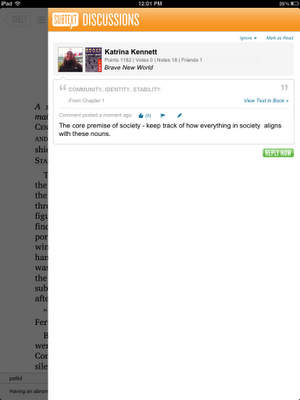I recently discovered
Subtext, a free app for the iPad, that allows you to collaboratively annotate texts. I have been very impressed with it in the few days I've been playing with it and look forward to testing it out in the classroom.
The Past: Personal Annotations
I love writing in my books. In personal ways, they are time capsules of who I was when I wrote in them (it seems I was quite philosophical about love in 11th grade). In academic ways, they are resources of ideas, connections, quotations, and vocabulary for conversations, lessons, and papers.
However, as a 10th and 12th grade English teacher in a public high school, I cannot ask my students to have the same personal dialogue with our department's shared texts. Yet, I want them to have an equivalent academic conversation. While there are many strategies for tracking active reading (post-its, bookmark logs, etc), none capture the same connection as scribbling in the margins, keeping track of themes at the back of the book, and dog-earing very important pages. Students love borrowing my 'teacher copy,' as they claim 'it has all the answers' and I often wish I could share my expertise beyond those individual students.
The Present: Subtext as Annotation Tool
What:
Subtext is an iPad app that allows you to collaboratively annotate a text. Right now you can access texts that you and anyone else can comment on. Soon, Subtext will release their Subtext in Education version, which will allow for creating private groups.
How: Sign into Subtext using your Google account.
You will use Subtext to access
.ePub files.
To open any .ePub file in Subtext, download or purchase it from the Google Bookstore, download it from Project Gutenberg, or access an .ePub of any file (article, short story, poem, etc) and open in Subtext.
To create your own .ePub file, see Greg Kulowiec's explanation here. I have a bookmarklet in my browser to transform any page into a .ePub, then I can open it in iBooks, Subtext, or a variety of other apps.
Making Annotation Easy:
 |
| Highlighting a word brings up the definition in a subtle box at the bottom of the screen. For texts with difficult vocabulary, this would reduce disruptions. |
|
 |
| Add Note: pulls out selected quotation, gives options of a comment, question, poll, or quiz. Consider the potential to collect reactions at one point in the text, instead of at one time in class. |
|
 |
| You can respond with how you're feeling (confused, excited, etc). This could be a good way to track student comprehension / engagement through a chapter. |
|
Making collaboration easy:
If two people have accessed the same text, you are able to view and comment at the same time. The updates are in real time within app: if I comment on your note, it will refresh on your iPad immediately. This would facilitate 1:1 classroom use, as there is no lag time between devices.
The implications of collaborative active reading in a classroom are staggering. With an anchor text, students could read at their own pace, but still benefit from the insights of their classmates.
Here are just a few ways off the top of my head I might use Subtext in the classroom:
Reading a short story:
- ask questions of the text
- answer teacher-generated questions at checkpoints
- collect student reactions at important moments or at specific quotations
- easily access word definitions
- share and respond to analysis of quotations, characters, setting, etc.
Reading a newspaper article:
- crowdsource outside links to a main article (in a similar way as hyperlinking functions within Wikipedia)
- comment on the validity of sources and analyzing how they're used in the text
- easily access word definitions
Reading a compilation of poems:
- identify poetic terms and analyze their effect within the poem
- crowdsource analysis and questions off of a teacher lecture
- at checkpoint, create found poetry off of main poem to capture essence of the poem
- link to literary criticism, readings of the poem (audio and video), images inspired by the poem, etc.
- simply bookmarking a page (or am I missing this ability?)
- some sort of 'blank back page' to keep running ideas on
I'd like to be able to:
- highlight scattered words on a page all at once and write one comment on the group of them. This allows for a 'word study' of a paragraph.
- tag quotations/pages with specific ideas (for example: if there is a flower motif in the book I would want to be able to tag each time a flower appears)
- compile quotations by user, or by tag. As a student this would be helpful so I could write a paper on that flower motif by having a document of all of the associated quotations. As a teacher, I could see what quotations specific students pulled out. (I'm thinking of how easy it is to do both of these in the Diigo iPad app)
- link to other moments in the same book - there is the option for adding a web link, but what if I wanted to connect a specific moment in Chapter 3 to one in Chapter 17?
I'm very much looking forward to playing with this app - how could you see yourself using it in your classroom?